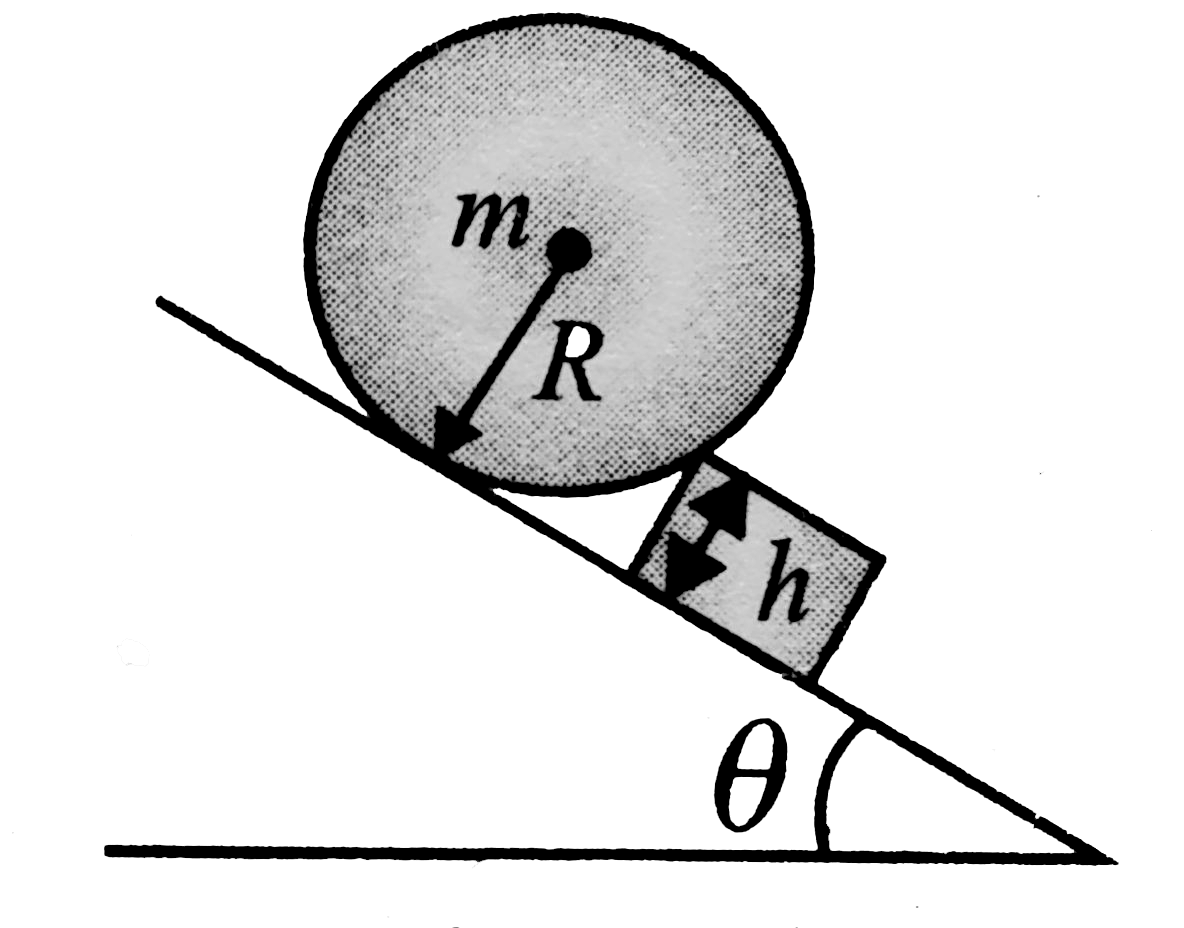A sphere of mass 20 kg is suspended by a metal wire of unstretched length 4 m and diameter 1 mm. When in equilibrium there is a clear gap of 2 mm between the sphere and the floor. The sphere is gently pushed aside so that the wire makes an angle θ with the vertical and is released. Find the maximum value of θ so that the sphere does not rub the floor. young's modulus of the metal of the wire is 2.0×1011Nm−2. Make appropriate approximation.
The correct Answer is:C, D
To solve the problem step by step, we will follow these steps:
Step 1: Understand the Problem
We have a sphere of mass m=20kg suspended by a wire of length L=4m and diameter d=1mm. There is a gap of 2mm between the sphere and the floor when in equilibrium. We need to find the maximum angle θ such that the sphere does not touch the floor when it is pushed aside and released.
Step 2: Calculate the Radius of the Wire
The radius R of the wire can be calculated from the diameter:
R=d2=1mm2=0.5mm=5×10−4m
Step 3: Calculate the Force Acting on the Wire
The force acting on the wire due to the weight of the sphere is given by:
F=mg=20kg×9.81m/s2=196.2N
Step 4: Calculate the Area of the Wire
The cross-sectional area A of the wire is given by:
A=πR2=π(5×10−4m)2=π×25×10−8m2≈7.85×10−8m2
Step 5: Calculate the Young's Modulus and Elongation
Using Young's modulus Y and the formula for elongation ΔL:
Y=FLAΔL
Rearranging gives:
ΔL=FLAY
Substituting the known values:
- F=196.2N
- L=4m
- A≈7.85×10−8m2
- Y=2.0×1011N/m2
Calculating ΔL:
ΔL=196.2×47.85×10−8×2.0×1011≈784.81.57×104≈0.050m=50mm
Step 6: Maximum Elongation Condition
The maximum elongation allowed is 2mm (the gap between the sphere and the floor). Therefore, we need to find the condition when the elongation is equal to 2mm or 0.002m.
Step 7: Relate the Angle θ to the Height
When the sphere is displaced to an angle θ, the vertical height h from the top of the wire to the center of the sphere is given by:
h=L−Lcosθ=L(1−cosθ)
The elongation ΔL can be expressed as:
ΔL=h−0.002m
Setting ΔL=0.002m:
L(1−cosθ)−0.002=0.002
L(1−cosθ)=0.004
Substituting L=4m:
4(1−cosθ)=0.004
1−cosθ=0.001
cosθ=0.999
Step 8: Calculate θ
Using the cosine inverse function:
θ=cos−1(0.999)≈0.0573radians≈3.29∘
Final Answer
The maximum value of θ so that the sphere does not rub the floor is approximately 3.29∘.
---
We have a sphere of mass m=20kg suspended by a wire of length L=4m and diameter d=1mm. There is a gap of 2mm between the sphere and the floor when in equilibrium. We need to find the maximum angle θ such that the sphere does not touch the floor when it is pushed aside and released.
The radius R of the wire can be calculated from the diameter:
R=d2=1mm2=0.5mm=5×10−4m
The force acting on the wire due to the weight of the sphere is given by:
F=mg=20kg×9.81m/s2=196.2N
The cross-sectional area A of the wire is given by:
A=πR2=π(5×10−4m)2=π×25×10−8m2≈7.85×10−8m2
Using Young's modulus Y and the formula for elongation ΔL:
Y=FLAΔL
Rearranging gives:
ΔL=FLAY
Substituting the known values:
- F=196.2N
- L=4m
- A≈7.85×10−8m2
- Y=2.0×1011N/m2
ΔL=196.2×47.85×10−8×2.0×1011≈784.81.57×104≈0.050m=50mm
The maximum elongation allowed is 2mm (the gap between the sphere and the floor). Therefore, we need to find the condition when the elongation is equal to 2mm or 0.002m.
When the sphere is displaced to an angle θ, the vertical height h from the top of the wire to the center of the sphere is given by:
h=L−Lcosθ=L(1−cosθ)
The elongation ΔL can be expressed as:
ΔL=h−0.002m
Setting ΔL=0.002m:
L(1−cosθ)−0.002=0.002
L(1−cosθ)=0.004
Substituting L=4m:
4(1−cosθ)=0.004
1−cosθ=0.001
cosθ=0.999
Using the cosine inverse function:
θ=cos−1(0.999)≈0.0573radians≈3.29∘
The maximum value of θ so that the sphere does not rub the floor is approximately 3.29∘.
Topper's Solved these Questions
- SOME MECHANICAL PROPERTIES OF MATTERBOOK - HC VERMA ENGLISHCHAPTER - SOME MECHANICAL PROPERTIES OF MATTEREXERCISE - Question For short Anser
18 Videos
- SOME MECHANICAL PROPERTIES OF MATTERBOOK - HC VERMA ENGLISHCHAPTER - SOME MECHANICAL PROPERTIES OF MATTEREXERCISE - Objective-1
29 Videos
- SOME MECHANICAL PROPERTIES OF MATTERBOOK - HC VERMA ENGLISHCHAPTER - SOME MECHANICAL PROPERTIES OF MATTEREXERCISE - Worked out Example
17 Videos
- SIMPLE HARMONIC MOTIONBOOK - HC VERMA ENGLISHCHAPTER - SIMPLE HARMONIC MOTIONEXERCISE - Question for short Answer
15 Videos
- SOUND WAVESBOOK - HC VERMA ENGLISHCHAPTER - SOUND WAVESEXERCISE - All Questions
133 Videos
Similar Questions
Knowledge Check
Find the moment of inertia of a sphere about a tangent to the sphere, while the mass of the sphere is M and the radius of the sphere is R.
A25MR2B65MR2C45MR2D75MR2
When a weight of 5kg is suspended from a copper wire of length 30m and diameter 0.5mm, the length of the wire increases by 2.4cm. If the diameter is doubled, the extension produced is
View SolutionA heavy & big sphere is hang with a string of length l. This sphere move in a horizontal circular path making an angle θ with vertical then its time period is
View SolutionA solid sphere of radius 1cm is melted to stretch into a wire of length 100 cm. Find the radius of the wire.
View SolutionFind the moment of inertia of a sphere about a tangent to the sphere, while the mass of the sphere is M and the radius of the sphere is R.
View SolutionA wire of length 15m and diameter 4 mm elongates 0.3mm when stretched by weigth of 2.20kg. Calulate the Young's modulus of the material of the wire.
View SolutionTwo identical small charged spheres, each having a mass m, hang in equilibrium the length of each string is l, and the angle made by any string with the vertical is θ. Find the magnitude of the charge on each sphere.
View SolutionWhen a wire of length 5m and diameter 1mm was stretched by a load of 5kg the elongation produced in the wire was 1mm. Find the energy stored in per unit volume of the wire?
View Solution

